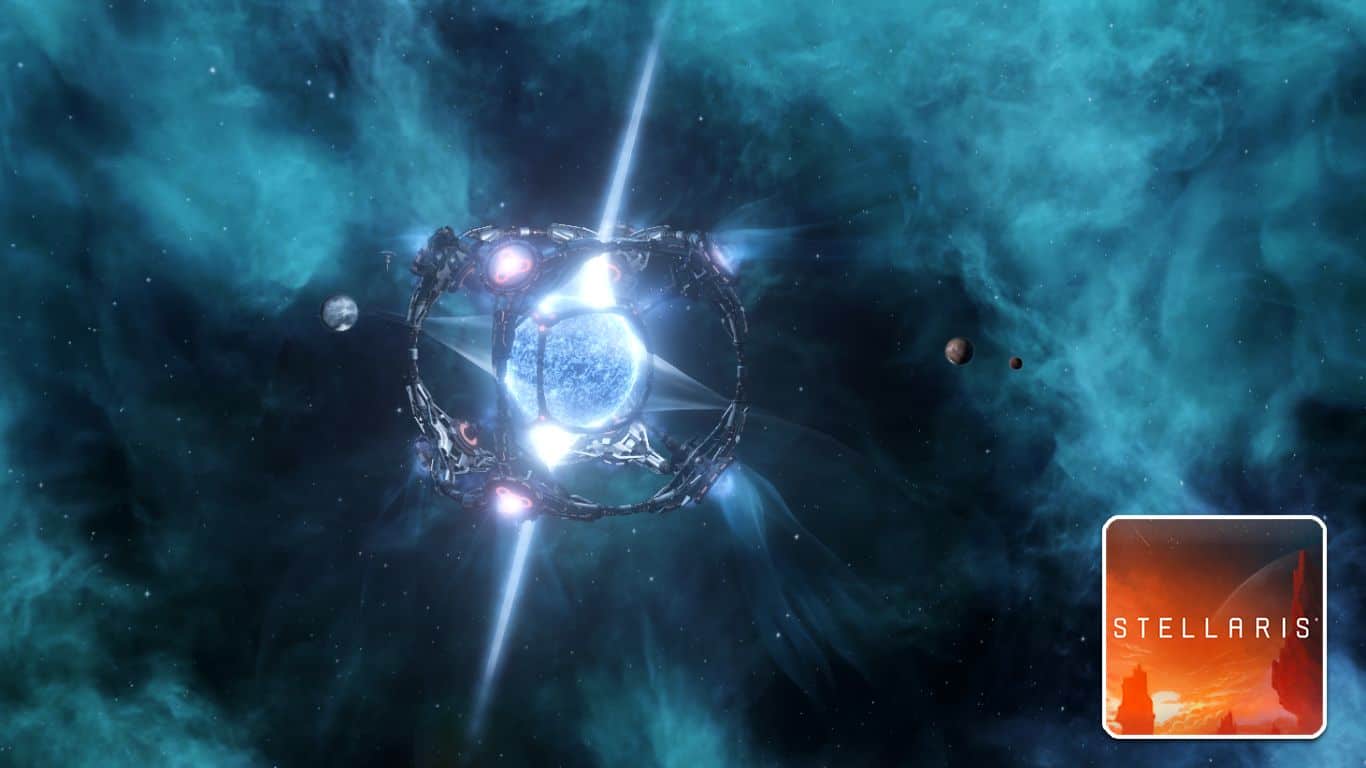For a lot of people, megastructures are the best game mechanic in Stellaris. Building structures that are larger than planets is awesome, and not only that, the strength they bring to your empire is second to none.
Megastructures are long-term projects, and you can only build one at a time. It stands to reason that you want the strongest ones built first. This begs the question, what are the best megastructures in Stellaris?
Recommended Read: What Is the Best DLC to Buy in Stellaris?
This guide is going to go through the ten best megastructures that exist in the game right now.
The top ten best megastructures in Stellaris are Hyper Relays, Mega Shipyard, Gateways, Mega Art Installation, Strategic Coordination Center, Ring Worlds, Sentry Arrays, Dyson Sphere, and Matter Decompressor.
Table of Contents
What Are the Best Megastructures in Stellaris?
When it comes to ranking the megastructures, there is an aspect of personal preference that comes into play. Also, some structures are a lot more useful to some empires than to others.
If you want to learn more about megastructures, there are many guides here on Gamer Empire for you to read.
10. Hyper Relays
The first megastructure on the list is the humble Hyper Relay. One of the cheapest and easiest to build, the Hyper Relay allows your ships to jump to neighboring systems without using the HyperLane network.
Normally, ships have to use sub-light travel to navigate from system to system. This doesn’t take a long time, but when ships have to make a lot of jumps, the time starts to add up.
If your ships are on the way to fight off invaders, the sooner you can get them into the action, the better. A Hyper Relay network has the power to shave months off of journeys through your own and allied space.

At only 25 influence, 500 alloys, and 100 rare crystals, Hyper Relays are the cheapest megastructure by a long way. As you can imagine, though, if you build a lot of these, this cost will grow fast.
Take your time building the network, and it will soon begin to pay for itself. A full guide on Hyper Relays is available on Gamer Empire.
9. Mega Shipyard
The first multi-stage megastructure on the list is the Mega Shipyard.
As you are likely already aware, all your ships get built at your star bases. The mega shipyard acts as a super shipyard and also provides empire-wide bonuses to ship construction speed.
There are four stages to its construction, and you build one in orbit of a single star. The construction site will cost you 2500 Unity and 3000 alloys. Every upgrade thereafter will set you back 2500 Unity and 10,000 alloys.
When completed, the mega shipyard can build 20 ships at once and doubles the build speed of ships across your entire empire.

Colossus class, Juggernaut class, and Titan class ships are also built at a Mega Shipyard. Negating the need to install their special construction modules on your starbases.
After you finish this project, your ship production will never be a problem again. Any losses you incur get replenished before you know it, and your large-scale ships arrive in no time at all.
You need to own the Federations DLC before deciding you want to build this structure.
8. Gateway
Gateways are a faster-than-light transport system. They allow ships to jump vast distances across space in an instant. Fans of the Stargate series will find this concept very familiar.

When you begin any game of Stellaris, gateways will spawn in random systems as determined by the game settings.
When your empire discovers one of these, they will have the chance to research a way to repair these long-abandoned portals.
Repairing gateways only costs 6000 energy and 2500 alloys. After learning how to repair gateways, your scientists will learn how to reverse engineer them as well.
Being able to build your own gateways is the bedrock of any late-game logistics network. Building one and the same system as your shipyards is a major boon to reinforcement times.
Stage one only costs 75 influence and 2500 alloys. A further cost 6000 energy and 2500 alloys will complete the second stage of construction.
Do not worry about enemies taking advantage of your gateways. They can’t. Building one in your capital system is not an easy ambush point for your foes. It would be nice to do it for them, though.
7. Mega Art Installation
The Mega Art Installation is a home for your empire’s finest and most treasured cultural possessions. Your empire has a long history, and what better way to display that beauty than in a space station the size of a sun?
Being a multi-stage structure, this art hub has three build stages and one construction site stage. Each stage provides huge amounts of unity and also boosts your amenities production with an empire-wide buff.
The construction site will cost you 2500 Unity and 5000 alloys. Every upgrade thereafter will cost another 2500 Unity and 15,000 alloys.
The art installation is unique, in that it has a 4th construction stage, only if you own the Ancient Relics DLC.

For 2500 Unity and an eye-watering 2000 Minor Artifacts, you can advance your installation to stage four. This stage provides 400 Unity and a 20% increase in amenities production.
This structure sings when used by a spiritualist empire.
Spiritualists love to produce unity and rush tradition trees. This beast of a space museum will race your empire ahead and allow you to get the best ascension perks early.
6. Strategic Coordination Centre
Running large fleets of spaceships that span the entire galaxy is no easy feat. Your empire’s ability to manage this displays itself in the form of various caps.
You have a naval capacity, starbase capacity, and a limit on the number of defense platforms that you can build.
Your empire’s computer systems, Admirals, anchorages, and technology systems all do their best to reduce those pressures. The greatest weapon your empire has at fighting that issue? The Strategic Coordination Center.
This mammoth of a space station is chock-full of soldiers, computers, radars, servers, and everything else that helps a navy run smoother.
As you upgrade it, you obtain the ability to build flotillas that will make your enemies think you are compensating for something.

The costs for the site and upgrades are the same as other megastructures. 2500 Unity and 5000 alloys for the site. 2500 Unity and 15,000 alloys for any upgrade afterward.
Genocidal empires can find great benefits in rushing this structure early. Often, the bigger fleet wins, and without one of these, no other empire will be able to match your firepower.
5. Ring World
Halo players will have a good understanding of what a Ring World is. In Stellaris, they are a giant ring habitat built around a sun.
This is a Galactic Wonder Structure. You will need the Galactic Wonder ascension perk to build one.
Almost every megastructure in the game has a build limit of one. Ring Worlds are exempt from this rule. You can build as many as you like, provided you have the space and resources.
A completed ring comprises four habitable sections and has five phases. The construction site will cost 300 influence and 5000 alloys. Every upgrade after this costs 10,000 alloys.
In return, you get four size 10 habitable sections.
All species that live on a ring world have 100% habitability, meaning you no longer need to worry about what pops live there.
The districts on ring worlds are unique and far more lucrative than the standard set you can build on planets.

Despite the high costs and long build time, ring worlds can pay for themselves several times over before a game is complete.
4. Sentry Array
If you cannot see what your enemy is doing, how do you have any hope of defeating them in open combat?
The Sentry Array will allow your empire to know how your enemy folds their shirts, as well as where their navy is mustering.
Including the construction site, a Sentry array has five stages to complete. Completing it should be something you want to rush, as this is when this megastructure goes from being good to astonishing.
When stage four of the sentry structure is complete, the fog of war on the galaxy disappears forever. You can see through nebulae and to the farthest reaches of the galaxy (including the L-Gate cluster).

You also get large bonuses to your base intel level, which can allow you to see the components installed on different empires’ fleets.
This is the ultimate spy weapon in Stellaris. It is also a lot cheaper and faster to build than the other multi-stage megastructures. At only 10,000 alloys per upgrade, it is a good choice for your first megastructure.
3. Dyson Sphere
Named after the British mathematician and physicist Freeman Dyson, the Dyson Sphere has the power to harvest the energy of an entire star.
Think of it like a cocoon that traps all the star’s energy within and then extracted by your empire.
After finishing this structure, your empire will seldom ever have to worry about energy production ever again. A completed structure provides you with a dizzying 4000 energy credits per month.
For context, you would need over 650 technician workers to match this output.
There are seven stages to this galactic wonder. This includes the construction site phase and one phase locked behind the kaleidoscope quest line.

Completing this quest line allows you to upgrade your Dyson Sphere to phase six.
It will only cost 3000 Unity and 2500 rare crystals. After a year of construction, your sphere will produce 600 Unity and buff amenity production by 30%.
That is on top of the 4000 energy credits per month.
2. Science Nexus
Depending on the type of empire you have, number three and number one could swap places on the list. The Science Nexus will never lose its place in the pecking order, regardless of your empire type.
Of all the non-galactic wonder megastructures in Stellaris, this one is light-years ahead of them all. The earlier you can get this project finished, the greater the reward is as well.
Research is the most valuable resource in Stellaris because it does everything.
Research leads to economic improvements, new weapons, stronger ships, more civic points, new buildings, and a lot more than we can list here.
A fully completed Science Nexus will increase all three research disciplines by 300 per month.
Depending on what stage of the game you are at when you build it, this has the potential to double your research output.

There is also a flat percentage increase in research speed as well, further boosting your opportunity to get ahead of your competition.
At 50,000 Alloys and 20,000 Unity, this structure is a complete steal. If you want a great chance at combatting the late-game threats, you will need late-game technology, and the Science Nexus is the fast lane to that tech.
1. Matter Decompressor
The final megastructure on this list is the matter decompressor. This technology isn’t routed in any sort of reality, but that doesn’t make it any less cool.

Construction work for this “mining laser” takes place around a black hole.
A black hole is a point in space where an exorbitant amount of mass is packed into a small space. This creates a gravity force so strong that nothing can escape.
The decompressor extracts the mass trapped in the black hole’s gravity field, extracting the useful minerals contained within.
The result, for you, is a source of minerals far greater than most empires will ever need.
A completed decompressor costs 22500 Unity and 55,000 alloys.
In return, you receive a colossal 2000 minerals per month. Even Lithoid empires, which feed on minerals, will have a hard time spending all of that.
If you ever spot a black hole near your borders in the early game, it will serve you well to prioritize taking it into your territory.
There are only a finite amount of black holes in the galaxy and securing one is the first step in the decompressor construction journey.
A final note, you will need the Megacorp DLC to build the matter Decompressor.
Remember, you are probably better off building all the megastructures rather than being picky. So get out there and build all of them.
This is everything you need to know about, what are the best megastructures in Stellaris.
If you have any questions or suggestions for this guide, please let us know in the comments section below. Thank you for reading.




